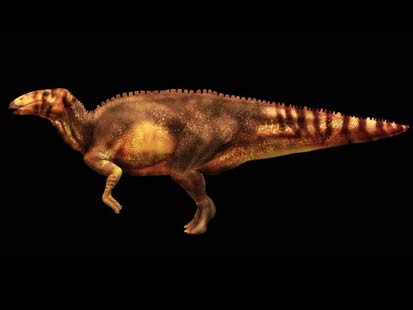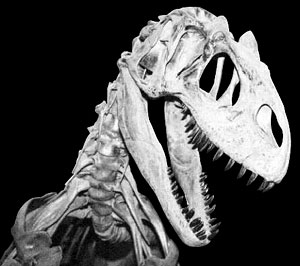I can’t help but laugh at the process by which things become popular in society. One can write various well thought out posts, or web pages that are heavily referenced, and rarely receive a response.
Shoot from the hip and/or spout out a controversial opinion, though, and all of a sudden the traffic starts to spike.
Hence why sites like badastronomy.com took years to get a devoted following, while LOL cats skyrocket to the top of the charts within days.
Case in point with History Channel’s recent crockumentary: Jurassic Fight Club.
I wrote a piece describing my thoughts on this terrible show. In it I explained exactly what was wrong with the series, and precisely what my gripe was with its main contributor: “Dinosaur George” Blasing.
That’s all fine and good. Time passes and we all move on. Then, I discover that History Channel actually has allowed folks to watch this show online, and one day out of boredom, I decide to see if the show might have gotten any better. Seeing that the quality has continued to slide downhill, I officially give the show up for dead, but not before ripping into it one more time. This time, I get to the heart of the matter, and don’t bother being even handed.
The result? A spike in traffic and the appearance of some George Blasing apologists.
Ah, how funny the internet can be.
Adding to said hilarity, I was recently informed of the fact that old “Dinosaur George” himself had been to my site, and had commented on it in his blog. Apparently I had touched a nerve, so now his fans feel the need to protect their favourite figurehead.
That’s all fine and good. I don’t much care. As I had stated before, as far as I’m concerned JFC is just more “documentary” sewage being pushed out by Discovery Channel A&E and its subsidiaries.
Still, I can’t help but notice a theme with some of these apologists. A theme that I can blame on old “Dinosaur George” himself. Apparently everyone thinks that I have issues with Mr. Blasing, because he is not an accredited academic.
Or as George Blasing put it: “There is a very, VERY small group of people within the paleontology community who feel that their science should be treated like a private club, where no one outside of their tiny group of likeminded buddies can participate.”
I’m afraid Mr. Blasing, and his fans have missed the point of my contention completely. My issue with “Dinosaur George” has little to do with his lack of formal training. True, I think that his lack of any real training in this field, poses a detriment to him, but as I wrote earlier, there is nothing wrong with being an amateur, or just a big dinosaur fan. Most new dinosaur finds come from amateurs, and not professionals. Furthermore, a doctorate, while important, does not necessarily make one qualified for a particular task. Look at “creation scientist” Dr. Duane Gish, or radio personality Dr. Laura Schlessinger. One can be an official academic and still be a Fruit Loop shy of a full bowl.
No, qualifications are not what bug me about Mr. Blasing. It’s the fact that he presents himself as being equivalent to the scientists he interviews. “Dinosaur George” is masquerading around as an authority figure on these matters. He bills himself on the show as a “Paleontology Expert.” So for those people who don’t bother looking into exactly what that means, “Dinosaur George” comes off as an authority on par with Dr. Thomas Holtz, or Dr. Larry Witmer.
So when Mr. Blasing spouts off something patently wrong like “dromaeosaurs could breathe through their bones,” or “megalodon was the size of a jumbo jet,” the audience at home will come away accepting that as a fact. Mind you, this is not me complaining about “Dinosaur George” taking a matter of fact stand on one particular theory. Mr. Blasing has repeatedly made glaring mistakes on specific facts about animals. Saying that “megalodon” was the size of a 747 is just plain wrong. Jumbo jets are substantially longer than 50ft (more like 240ft), and a heck of a lot heavier.
Another one I heard about recently was from that same “megalodon” episode. Apparently it was stated that “megalodon” could “taste” the water around it, because of taste buds in its skin called denticles. Once again, this is flat out wrong. It doesn’t take much effort to learn that denticles are sharp outgrowths of the dermis in shark skin. The result feels like teeth, or sandpaper. It makes the shark’s skin rough. It does not allow them to taste the water with their bodies. However, because “Dinosaur George” said it, his followers will take it as fact (as evidenced by some of the commenters in the previous post).
To reiterate; my problem with Mr. Blasing is that he is impersonating a professional in the field, and in the process, he is misleading the public when he talks so matter of factly about some of his subjects.
It is unfortunate. I explained all of this previously in my first post on JFC. Judging from the date of “Dinosaur George’s” blog post, it was apparent that this was the one he had read. Rather than deal with the impersonation and rampant speculation part of the show, Mr. Blasing instead wound up focusing on my pointing out his lack of credentials.
Still, things aren’t all bad with “Dinosaur George.” While reading his behind the scenes blog, I was happy to see one good thing about the show:
I was very careful not to put any of our experts into situations where they were made to look like they supported a theory that I knew they were opposed to. I made sure that I took on the role of speculating how the fights could have occurred, because they were based solely on modern animal behaviors and not any real fossil evidence. Since most of our experts owe their careers to the scientific community, they have the deal with their peers and those that they answer to. So to insulate them from being attacked by those within their industry, I made sure to keep them out of the fight scenes and instead used them to support the factually based stuff earlier on in the show.
At least “Dinosaur George” was willing to do this. So JFC is at least one step better than Animal Face-Off was.
Still, when all is said and done, I stand by my initial claim. “Dinosaur George” still comes off as a fanboy. That JFC turned out to be his pet project, does little to alleviate this thought. Rather than use his funds to talk about how these animals may have lived, or how we know what we know about prehistoric life, he used his funds to make a series of films devoted to prehistoric cage matches. As if the only time animals are interesting is when they are fighting each other. Each show boiled down to which animals is better.
To me that sounds an awful lot like being a fanboy.
~ Jura














